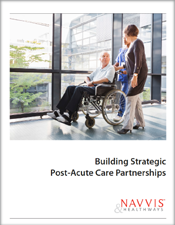Resource:
Building Strategic Post-Acute Care Partnerships
Hospitals looking to successfully manage the full continuum of care should ensure that their strategy considers opportunities for alignment initiatives with their post-acute care partners.
When patients are ready to leave the acute care setting, they may be discharged either home (with or without home health) or to a postacute care (PAC) environment. According to the Centers for Medicare & Medicaid Services (CMS), more than 40 percent of Medicare recipients are placed in a PAC setting after hospital discharge. PAC provider types include skilled nursing facilities (SNFs), inpatient rehabilitation facilities (IRF), long-term acute care (LTAC) hospitals or longterm care (LTC) facilities.
The potential for care to become fragmented during this transition is high, however. As patients pass through the care of multiple providers, the providers may not consistently and accurately communicate information on the course of treatment with all those involved in the patient’s care.1 Quality of care, in turn, is adversely affected.
One of the key indicators of quality, as identified by CMS, is a hospital’s readmission rate within 30 days of a hospital discharge for selected diagnoses. Under scrutiny because of their high readmission risks are acute myocardial infarction, heart failure and pneumonia diagnoses, as well as the 2014 addition of patients undergoing elective primary total hip arthroplasty and total knee arthroplasty.
Many readmissions are thought to be avoidable and account for $12 billion in Medicare spending.2 The CMS readmission penalties are assigned to the discharging hospital, even though once “handoff” occurs, the PAC provider assumes responsibility for continuing efforts to ensure quality outcomes and avoid readmissions.
With reimbursement models increasingly recognizing value and quality over volume, hospitals need to focus on quality outcomes throughout the continuum of care. The transition from acute to post-acute care settings, in particular, needs to be handled carefully, with an emphasis on proper communication and planning to ensure that the integrity of the care process is not compromised. Read the full Whitepaper to learn more.

